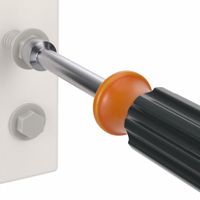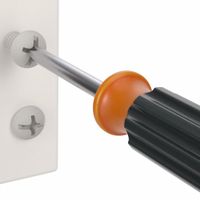Call +(254) 703 030 000 / 751 483 999 / 721 704 777
- Home
- Tools
- Hand Tools
- Screwdrivers Nut Drivers Keys
.....Read More
Frequently Asked Questions
What is the difference between a screwdriver and a nut driver?
A screwdriver and a nut driver are both hand tools used for fastening, but they serve different purposes and are designed for different types of fasteners.
A screwdriver is a tool used to drive screws into materials or to remove them. It consists of a handle and a shaft with a tip that fits into the screw head. Screwdrivers come in various types, including flathead (slotted) and Phillips, among others, each designed to match the specific shape of the screw head. The primary function of a screwdriver is to apply torque to screws, allowing them to be driven into or removed from materials like wood, metal, or plastic.
On the other hand, a nut driver is specifically designed for tightening or loosening nuts and bolts. It resembles a screwdriver in appearance, with a handle and a shaft, but instead of a flat or cross-shaped tip, it has a socket at the end. This socket fits over the hexagonal shape of nuts and bolts, allowing the user to apply torque. Nut drivers are often used in applications where nuts and bolts are the primary fasteners, such as in automotive work, machinery assembly, and electronics.
In summary, the key difference lies in their intended use: screwdrivers are for screws, while nut drivers are for nuts and bolts. The design of their tips or sockets reflects this difference, with screwdrivers having flat or cross-shaped tips and nut drivers having hexagonal sockets.
How do you use a hex key?
To use a hex key, also known as an Allen wrench, follow these steps:
1. **Identify the Correct Size**: Determine the size of the hex key needed by matching it to the hexagonal socket of the screw or bolt. Hex keys come in various sizes, typically measured in millimeters or inches.
2. **Insert the Hex Key**: Insert the short end of the hex key into the hexagonal socket of the screw or bolt. Ensure it fits snugly to avoid stripping the socket.
3. **Tightening**: To tighten a screw or bolt, turn the hex key clockwise. Use the longer end of the hex key for more leverage if the screw is particularly tight or if more torque is needed.
4. **Loosening**: To loosen a screw or bolt, turn the hex key counterclockwise. Again, use the longer end for additional leverage if necessary.
5. **Apply Steady Pressure**: Apply steady, even pressure to avoid damaging the screw or the hex key. Avoid using excessive force, which can strip the socket or break the key.
6. **Use the Right Angle**: For better control and to prevent slipping, hold the hex key perpendicular to the screw or bolt. This ensures maximum contact and reduces the risk of rounding the edges of the socket.
7. **Check Alignment**: Periodically check the alignment of the hex key in the socket to ensure it remains properly seated, especially if the screw or bolt is difficult to turn.
8. **Storage**: After use, store the hex key in a designated place, such as a tool box or a hex key set holder, to prevent loss and ensure easy access for future use.
By following these steps, you can effectively use a hex key to tighten or loosen hexagonal screws and bolts.
What sizes do Torx keys come in?
Torx keys, also known as star keys or star wrenches, come in a variety of sizes to fit the corresponding Torx screw heads. The sizes are typically denoted by a "T" followed by a number. Common sizes include:
- T1
- T2
- T3
- T4
- T5
- T6
- T7
- T8
- T9
- T10
- T15
- T20
- T25
- T27
- T30
- T40
- T45
- T50
- T55
- T60
- T70
These sizes are standardized, and the number generally increases with the size of the key. Smaller sizes like T1 to T10 are often used in electronics and small devices, while larger sizes like T40 to T70 are used in automotive and industrial applications.
What are service keys used for?
Service keys are used to facilitate secure and authenticated access to services in cloud environments. They are essentially credentials that allow applications or users to interact with a service without requiring user-based authentication. Here are the primary uses of service keys:
1. **Authentication**: Service keys authenticate applications or services to access other services. They act as a form of identity verification, ensuring that only authorized entities can interact with the service.
2. **Authorization**: Once authenticated, service keys help determine what actions the application or service is permitted to perform. They can be configured with specific permissions, allowing for fine-grained access control.
3. **Automation**: In automated environments, such as CI/CD pipelines, service keys enable seamless integration and interaction between different services without human intervention. This is crucial for maintaining continuous deployment and integration workflows.
4. **Security**: By using service keys, sensitive operations can be performed securely. They help in encrypting data in transit and ensuring that only trusted applications can access sensitive information.
5. **Scalability**: Service keys allow for scalable interactions between services. As applications scale, service keys ensure that new instances can authenticate and communicate with necessary services without manual configuration.
6. **Monitoring and Auditing**: Service keys can be tracked and monitored, providing insights into which applications are accessing services and how they are being used. This is important for auditing and compliance purposes.
7. **Decoupling**: They enable decoupling of services, allowing them to interact without being tightly integrated. This promotes modular architecture and easier maintenance.
In summary, service keys are crucial for secure, efficient, and scalable service interactions in cloud environments, providing authentication, authorization, and automation capabilities.
How do you choose the right screwdriver for a job?
To choose the right screwdriver for a job, consider the following factors:
1. **Screw Type**: Identify the screw head type. Common types include flathead (slotted), Phillips, Torx, hex, and Robertson. Match the screwdriver tip to the screw head.
2. **Size**: Ensure the screwdriver tip size matches the screw head size. Using the wrong size can strip the screw or damage the tool.
3. **Material**: Choose a screwdriver made from durable materials like chrome-vanadium steel for longevity and strength.
4. **Handle Design**: Opt for an ergonomic handle for comfort and better grip, especially for tasks requiring significant torque.
5. **Magnetic Tip**: A magnetic tip can help hold screws in place, making it easier to start threading them.
6. **Length**: Select the appropriate shaft length. Longer screwdrivers provide better reach, while shorter ones offer more control in tight spaces.
7. **Insulation**: For electrical work, use insulated screwdrivers to protect against electric shock.
8. **Precision**: For delicate tasks, such as electronics, use precision screwdrivers with smaller tips and finer control.
9. **Set vs. Individual**: Consider a set if you frequently work with various screw types and sizes, ensuring you have the right tool for any job.
10. **Quality**: Invest in high-quality tools to ensure reliability and reduce the risk of damage to screws and workpieces.
By evaluating these factors, you can select the most suitable screwdriver for your specific task, ensuring efficiency and preventing damage.
Can hex keys be used on Torx screws?
No, hex keys cannot be used on Torx screws. Hex keys, also known as Allen wrenches, are designed for screws with a hexagonal socket. Torx screws, on the other hand, have a star-shaped socket with six rounded points. The design and shape of these two types of screws and their corresponding tools are fundamentally different, which means they are not interchangeable.
Using a hex key on a Torx screw can lead to several issues. The hex key may not fit properly into the Torx screw, leading to a poor grip. This can result in stripping the screw head, making it difficult to remove or tighten the screw. Additionally, using the wrong tool can damage both the tool and the screw, potentially leading to further complications in the assembly or disassembly process.
For proper use, it is essential to use a Torx driver or Torx bit that matches the specific size of the Torx screw. Torx drivers are specifically designed to fit the star-shaped pattern of Torx screws, providing a secure grip and reducing the risk of stripping. This ensures efficient torque transfer and minimizes the risk of damage to both the tool and the screw.
In summary, while it might be tempting to use a hex key in the absence of a Torx driver, it is not advisable due to the potential for damage and inefficiency. Always use the correct tool for the specific type of screw to ensure the best results.
What materials are screwdrivers typically made from?
Screwdrivers are typically made from a combination of materials to ensure durability, functionality, and comfort. The main components of a screwdriver are the handle, the shank, and the tip or blade.
1. **Handle**:
- **Plastic**: Most screwdriver handles are made from durable plastics such as cellulose acetate or polypropylene. These materials are chosen for their resistance to impact, chemicals, and temperature changes. They also provide a comfortable grip.
- **Rubber or Thermoplastic Elastomers (TPE)**: Some handles are coated with rubber or TPE to enhance grip and comfort, especially in ergonomic designs.
- **Wood**: Less common today, but some traditional or specialty screwdrivers may have wooden handles for aesthetic or specific functional purposes.
2. **Shank**:
- **Steel**: The shank, which connects the handle to the tip, is typically made from steel. High-carbon steel or alloy steel is often used for its strength and resistance to bending or breaking.
- **Chrome Vanadium Steel**: This is a popular choice for its enhanced strength and resistance to corrosion.
- **Stainless Steel**: Used in some screwdrivers for its corrosion resistance, though it may not be as strong as other steel alloys.
3. **Tip/Blade**:
- **Steel**: Like the shank, the tip is usually made from hardened steel to withstand wear and tear.
- **Hardened and Tempered Steel**: This process increases the tip's durability and resistance to deformation.
- **Magnetic Tips**: Some screwdrivers have tips that are magnetized to hold screws in place, which is achieved by magnetizing the steel.
These materials are selected to ensure that screwdrivers are robust, reliable, and comfortable to use in various applications.


